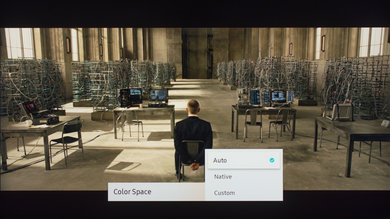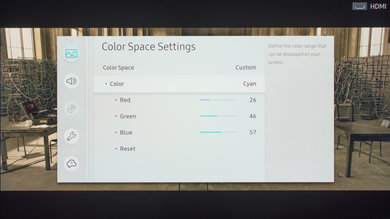These are the settings we used to calibrate the Samsung 55 inch MU7000 TV (UN55MU7000) and we expect them to be valid for the 40" version (UN40MU7000), 49" version (UN49MU7000) and the 65" version (UN65MU7000). These settings are good for any content, from TV shows to movies and gaming. For gaming, some little adjustments need to be done and they are listed below.
General Settings
The first thing we did was to turn off all of the 'Eco Solution' settings since we did not want the backlight level to change during our calibration. This is recommended if you don't want the luminance of the TV to change automatically depending on the room brightness.
For movies and TV content, we selected the 'Movie' 'Picture Mode', since it is the picture mode that brought us the closest to our calibration goal. This brings the image quality closest to what the content creator intended it be.
The 'Picture Size Settings' was set to '16:9 Standard' as this is the screen format of the MU7000. The 'Fit to Screen' option was also set to 'On' and this is particularly useful if you are connecting your PC to the MU7000, as it can help fix overscan without having to change the video card settings.
To have a luminosity closest to our calibration target of 100 cd/m² in our totally dark room, we used a 'Backlight' setting of 5. Note that you should change 'Backlight' to match your room lighting and it won't affect the picture quality. We left the 'Brightness' to 0 and the 'Contrast' to 95. We found that when the contrast was set higher than 95, it was introducing come clipping in the whites. We left the 'Sharpness' to 0 to avoid any oversharpening. We left the 'Tint (G/R) to its default value of 'G50 and R50'.
We turned off 'Digital Clean View', but if you intend to watch some older low-resolution content, you may want to set it on to make the content smoother and with fewer compression artifacts. For our calibration, we left the 'Auto Motion Plus Settings' Off (more on that later), left 'Contrast Enhancer' off and left unticked 'HDR+ Mode' (this extrapolates HDR from SDR).
In the 'Auto Motion Plus Settings' tab, you can control the motion interpolation and the black frame insertion feature. When 'Auto Motion Plus' is set to 'Custom', You can adjust the slider of 'Judder Reduction' to add the amount of soap opera effect you want. The 'LED Clear Motion controls the black frame insertion and can help to reduce the motion blur, but it will dim the TV image considerably and will introduce some screen flicker. You can read here to learn more about the black frame insertion feature.
We selected the 'Warm2' 'Color Tone' since it was the color temperature the closest to our calibration goal, but you can choose a colder color temperature if you find the color of the screen too warm (yellow or red). The 'Gamma' 'BT.1886' was adjusted to 1 to reach our calibration goal of 2.2 gamma. Note that here, the gamma type is set automatically depending on the type of content you are watching. You can only adjust the gamma curve with the slider (plus or minus) if you find there is black crush or if dark scenes are not deep enough.
In the 'Color Space Settings', it is preferable to leave it to 'Auto'. When set to auto, the color space changes to match the type of content you are watching automatically. If you want to calibrate your TV for SDR content (Rec.709), you must set it to custom. Afterward, you must set it back to 'custom' to benefit from your calibration.
HDR Settings
For watching HDR content via an HDMI connection, it is important to set the 'HDMI UHD Color' on for each HDMI input that will receive the HDR content. This will permit the HDMI port to transmit all the bandwidth needed for HDR. If the 'HDMI UHD Color' is not turned on, some devices will not detect the MU7000 as being compatible with HDR. For HDR content, it is also preferable to set the 'Backlight' to maximum and set the 'Color Space Settings' to 'Auto'.
SDR Gaming Settings
To have the best input lag while playing games via a video game console or PC, you can keep the general settings mentioned above and turn on 'Game Mode' from the 'External Device Manager'.
If you are playing on a PC, then set the input icon to 'PC' if you want to enable the chroma subsampling.
HDR Gaming Settings
For HDR gaming apply the same HDMI settings mentioned in the HDR settings and game settings above. Note that when in game mode, the TV won't change the backlight setting automatically, so it is preferable to set the backlight to maximum.
White Balance Settings
The following are the results of the white balance and colorspace calibration on our unit. They are provided for reference, and should not be copied as the calibration values vary per individual unit even for the same model and same size as the TV we reviewed due to manufacturing tolerances. If you want to try them you will need to enter all values shown, as all of them are active at the same time. If you end up with worse picture quality, simply reset them to the default values.


















































































